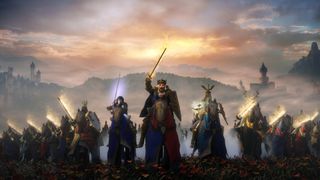There are lots of issues we do in Whole Struggle as a result of they appear like widespread sense, though we do not know if the methods behind the scenes actually again them up. I put my archers on hills as a result of I feel I bear in mind a loading display screen tip saying that raised elevation will increase your harm output, however by how a lot? And does it apply equally to melee assaults?
Thankfully, Artistic Meeting not too long ago started explaining what goes on below the hood of Whole Struggle: Warhammer 3 in a collection of weblog posts referred to as the Characteristic Focus collection, that are doing a fantastic job translating these assumptions into precise numbers, even when they slip into algebra at occasions, like saying “coefficient” after they may simply say “multiplier”.
Elevation was the subject of the primary publish within the collection, which clarified that the harm multiplier primarily based on top distinction is calculated from the bottom of every mannequin. Which means, as CA put it, “being tall doesn’t really issue into elevation modifiers”. Seems my ogre chieftain, Giant Marge, doesn’t really get extra bonus harm when hitting goblins who’re 5 toes shorter.
For ranged harm the utmost bonus to wreck is 30%, which requires a top distinction of 40 meters. There’s additionally a harm penalty for taking pictures upwards, with the identical 40-meter distinction leading to an equal most harm penalty of 30%. “Flying models hover roughly 16 meters above the bottom,” the publish continued, “and they also profit from an elevation harm bonus of 12% if their goal is standing on floor degree.” That bonus will be elevated by situating flying models over tall terrain to extend the distinction between their hover top and flat floor. And sure, elevation does issue into melee harm calculations, although in melee the utmost distinction in elevation multiplier is one meter.
The elevation publish additionally clarified that we have been proper in assuming models would go quicker downhill and get fatigued quicker going uphill, although it notes that “no fatigue profit is gained by going downhill.” Oh, and in addition models which have the “Strider” attribute ignore principally all terrain penalties, together with the one about taking pictures up.
The newest publish within the collection is all about harm. It particulars how armor and armor-piercing harm work, in addition to resistances. Now we all know that when models are on hearth, therapeutic them is half as efficient as regular. Possibly watch for them to cease, drop, and roll earlier than you rush in to patch them up after the dwarfs with irondrake flamethrowers do their factor. One other necessary clarification: magical assaults do not ignore armor, which is nice information for the Bretonnians, who go into battle sporting extra protecting gear than American footballers.
There are apparently sufficient other ways you’ll be able to damage folks in Whole Struggle: Warhammer 3 that harm wants a second article to cope with the remainder of them. The subsequent within the collection shall be “trying on the particular quirks of Explosions, Vortexes and Wind results, cracking the case of how harm is utilized by Giant Monsters and Lords utilizing splash assaults, and opening the forbidden field labelled ‘Sport Ticks.'” Do not threaten me with an excellent time, Artistic Meeting. “Additionally on the best way are deep dives into projectiles and goal penetration. Plus, we’ll be parallel parking our approach into the subject of chariots, mass and prices.”
That is one thing to look ahead to, and can perhaps assist me determine why my Vampire Counts military by no means obtained a lot worth out of the Black Coach—an costly single-entity chariot that tended to underperform in comparison with different models, like a number of the native canines I rounded up and put spikes on.















